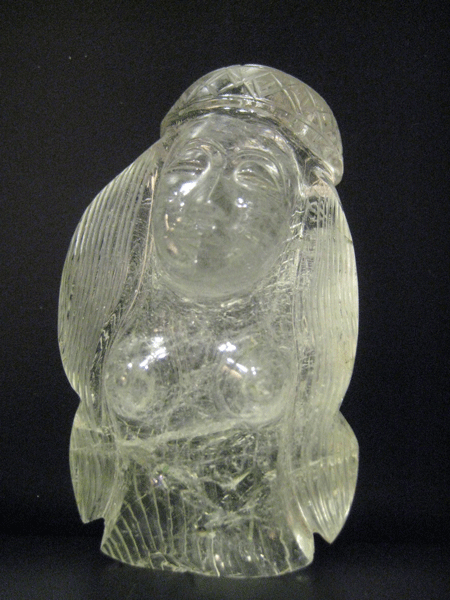Aquamarine Carving of a Woman, 1700 CE - 1850 CE
Aquamarine
2.1 x 3.35
OF.065
Further images
This exquisite piece of carved aquamarine dates to the later enlightenment, when the European social and intellectual elites were beginning to embrace the enormous varieties of cultural achievements beyond the...
This exquisite piece of carved aquamarine dates to the later enlightenment, when the European social and intellectual elites were beginning to embrace the enormous varieties of cultural achievements beyond the shores of their own continent. Based primarily upon martial and economic growth overseas, the advent of the European thalassocracies had led to enormous wealth and prosperity for certain social strata, and the reports, artefacts and stories that returned with the explorers did much to fuel the public imagination with a love for the exotic, and the ancient. This was the period of the Grand Tour, when young gentlemen were educated in the classics before all else, where Roman and Greek technologies and aesthetics were the primary inspiration for engineers, architects, artists and scientists throughout Europe. Accounts of derring-do and adventure, which were often embellished, led to generations of books and paintings that sought to express the Mysterious East, the Dark Continent of Africa, the virtually untouched Eden of the Antipodes, and, for our purposes, the Exotic Americas. Identification of this piece’s intended inspiration is done primarily on the physiognomy of the face; however, regardless of specific inspiration, this piece does evoke all that was de vogue in the 18th century – the exotic, sensual, noble savage of myth and legend, which was irresistible at the time.
The piece represents a bare-breasted torso of a woman from the apex of the head to just above the groin; the fact that the hollow for the inguinal ligament is represented on the right side makes it possible that the piece was slightly longer – and thus more explicit – at one stage, but that it was viewed as being too risqué. It is very expressionistic and reminiscent of the Art Nouveau period in its long tresses that run the full length of the back and down both sides of the body, and the simplified, fluid morphology of the body. The arms are not represented, perhaps being concealed beneath her hair. The face is Asiatic in general form, being comparatively flat with a broad yet fine nose, almond eyes and small, pursed lips under simplified, broad brows on a flat frontal. The head is crowned with an ornate ¾ circular hat without a brim, decorated with diamond hatching around the perimeter and small semicircular cross-hatching on the superior aspect. In rear view, the whole of the back is covered with small cross-hatching, except for the hair which has been gathered to each side. The manner in which it is represented seems to rule out the possibility of it depicting an East Asian, on the basis of facial morphology (which, while shared to a certain extent between the related East Asian and Native American groups, can nonetheless be differentiated), the lack of clothing (which seems to imply the ‘noble savage’) and the decoration of the headwear.
The base is ground flat and the piece stands well. This is a decorative, beautifully-executed piece of Enlightenment sculpture.
The piece represents a bare-breasted torso of a woman from the apex of the head to just above the groin; the fact that the hollow for the inguinal ligament is represented on the right side makes it possible that the piece was slightly longer – and thus more explicit – at one stage, but that it was viewed as being too risqué. It is very expressionistic and reminiscent of the Art Nouveau period in its long tresses that run the full length of the back and down both sides of the body, and the simplified, fluid morphology of the body. The arms are not represented, perhaps being concealed beneath her hair. The face is Asiatic in general form, being comparatively flat with a broad yet fine nose, almond eyes and small, pursed lips under simplified, broad brows on a flat frontal. The head is crowned with an ornate ¾ circular hat without a brim, decorated with diamond hatching around the perimeter and small semicircular cross-hatching on the superior aspect. In rear view, the whole of the back is covered with small cross-hatching, except for the hair which has been gathered to each side. The manner in which it is represented seems to rule out the possibility of it depicting an East Asian, on the basis of facial morphology (which, while shared to a certain extent between the related East Asian and Native American groups, can nonetheless be differentiated), the lack of clothing (which seems to imply the ‘noble savage’) and the decoration of the headwear.
The base is ground flat and the piece stands well. This is a decorative, beautifully-executed piece of Enlightenment sculpture.







